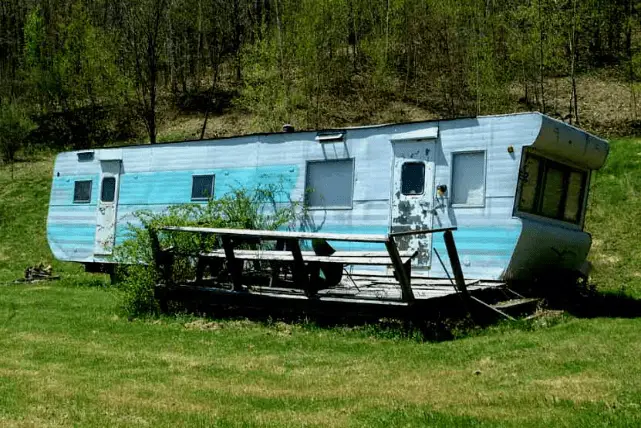This is a great question and one that should be considered carefully before making a purchase of a mobile home. What are your plans for the home?
- Will you be living in it full time?
- Will it be a vacation home?
- Will it be an investment property to rent out?
- Are you buying an older home or a newer one?
Carefully consider your answers to these questions in making a decision about what type of mobile home you may want to purchase.
Table of Contents
SHORT ANSWER
The U.S. Department of Housing and urban Development (HUD) tells us that the manufactured homes built today have a life expectancy of 30 to 55 years; of course depending on how well they are maintained. We feel this is a good estimate for the middle ground. In our experience we have seen some homes even older than 55 years that are in amazing condition. We’ve also seen others that are less than 15 years old that seem ready to be scrapped.
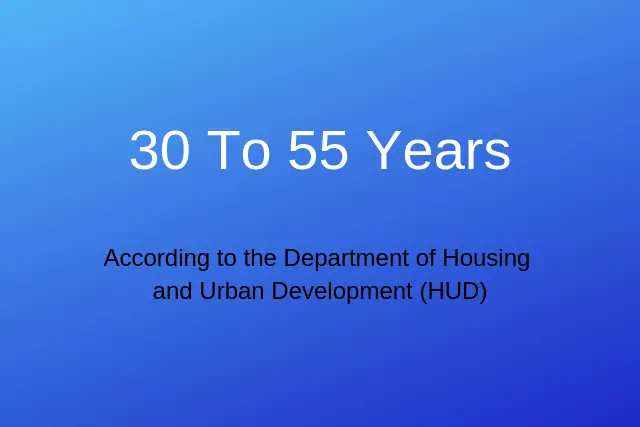
This HUD estimate is a great starting point, but there are a number of other variables that affect the lifespan of the home other than just maintenance.
Why Don’t Manufactured Homes Tend To Last As Long?
This is a question that many manufactured home owners would disagree with. There are plenty of examples of mobile homes lasting far longer than the HUD estimate of 30 to 55 years.
When the HUD building standards for manufactured homes was put into place in 1976 it created a uniform construction code that all manufactured homes must adhere to. This code has continued to be improved over the years; such as fire resistance, plumbing, wind resistance improvements and more have made the homes sturdier over the years.
Some of the best maintained manufactured homes are found in senior adult living parks. You’ll find plenty of these parks in Florida, Arizona and Texas. Many homes are 60s and 70s era vintage and are now from about 40 to 55 years old and are nearing the end of their serviceable lives.
The weather conditions have a lot to do with the longevity of the homes. In Florida, where there is a lot of rain and humidity, the materials used in the construction such as fiberboard, particle board and pressed board have been ravaged over time by the humidity. After putting on a couple of new roofs, fixing rotted floors and correcting other structural issues with the homes, many owners choose to haul off the old home and bring in a new one. Bringing in a home is not an inexpensive proposition. Take a look at our post on “How Much Does It Cost To Move A Mobile Home?”
In drier climates, such as in Arizona, where we are, many of these 40 to 55 year old mobile homes in senior parks are still in excellent serviceable condition. The drier climate does not seem to affect the homes as much as in wetter climates. This is true for site-built homes and cars as well.
The quality of the materials used tends to have a lot to do with how long the homes will last.
Quality Of The Materials Used In Construction
Manufactured homes are mostly made out of wood and metal. But, site-built homes are also made out of mostly wood and metal. So, why don’t manufactured homes tend to be as permanent as site-built homes?
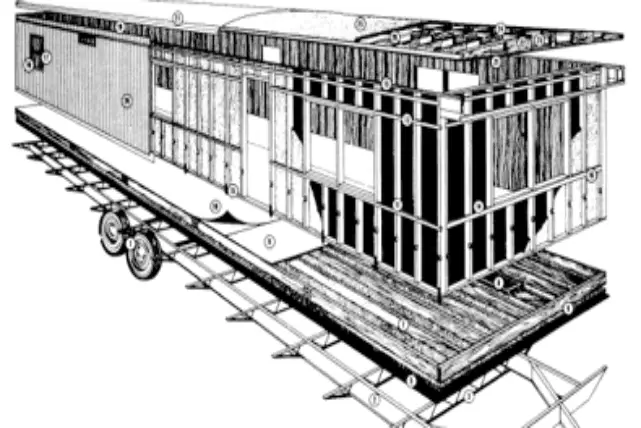
Manufactured homes tend to be much lighter than site-built homes. This is mainly because manufactured homes do not use bricks, mortar or cement in the construction. The actual materials used in both types of homes tends to be the same.
We recently purchased an older mobile home from 1969 that was installed on a very nice piece of land. The home itself had aluminum siding, a metal roof and old single pane crank out windows. It is a 12 x 60 home with a side room added on. We considered for quite some time about whether we wanted to remove this old home and replace it, or to renovate the old home. It seemed sturdy and sound.
One thing with this home I was very surprised at was how solid the floor felt. We’re used to buying homes where there are quite a few rotted areas or soft spots in the floors that need repairing. We ended up renovating this 49 year old home because of the solid condition we found it in.
About the same time, we purchased another 12 x 60 mobile home on a good lot that was a 1968 model. This one was just the opposite. It had not been maintained and was in such a condition that is was strictly a tear down. As we were having the home torn down, I was looking closely at the construction quality of the homes. Remember, this was a pre-HUD mobile home. The flooring was actually 1 inch thick plywood over steel beam girders (there weren’t any floor joists between the subfloor and the frame). This was a common way of doing flooring before HUD. The flooring was actually still in good condition, but, if any flooring work would have needed to be done, the way the floor was built would have made it very difficult to execute a repair.
Also, the outer walls and roof were constructed with 2 x 3 studs. There was almost no real insulation to speak of in the attic or walls. The interior walls were constructed of 1 x 2 boards spaced about 20” on center.
The difference between these two very similar homes was that the roof was well maintained on one home, but not on the other home. Also, the home in poor condition was ground set and the ground moisture came right up to where the outer walls touched the ground.
The Construction Process
The construction of a manufactured home is not meant to be temporary. The HUD construction standards put into place in June 1976 were meant to create a uniform construction quality for mobile homes nationwide. See our post on “What Is The Difference In Construction Between Manufactured Homes and Site-Built Homes?”.
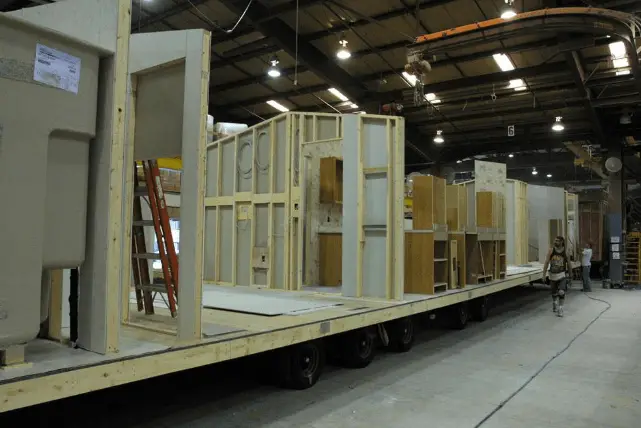
Site-Built homes are built on permanent foundations that in many cases can crack, sink or experience other problems. Manufactured homes are built atop a heavy steel chassis that will pretty much last forever. The chassis of a manufactured home is then supported by a foundation that goes from the chassis to the ground. These might be somewhat temporary such as metal piers and blocks, to something far more permanent such as cement piers on foundations and block walls around the perimeter.
Since manufactured homes are built in a factory, they are precision engineered and built so that they can withstand the movement that takes place when being transported.
The National Manufactured Home Construction and Safety Standards address the design and construction processes for manufactured homes. Federal standards ensure that manufactured homes are built to a uniform strength and durability standard. So, neither the materials used or the construction process are designed to compromise the longevity of a mobile home, yet we are told that the average longevity of a mobile home is 30 to 55 years. So what causes that?
What Impacts The Lifespan And Longevity Of Manufactured homes?
INITIAL INSTALLATION:
Many problems that tend to manifest later in the life of a mobile home have to do with improper installation initially. As we have discussed above, the design, as well as the construction process and materials were designed to last indefinitely. When a manufactured home is new, it must be transported to a home site and installed.
The installation process is technical and SHOULD NOT be done by inexperienced labor. We’ll discuss some of the areas that are affected by improper installation. But, whether you are buying a brand new manufactured home, or one that is older, you should have an experienced inspector make sure that the installation has been done properly and any problems rectified. This will make sure that your home lasts as long as possible.
FOUNDATION:
Just as with a site-built home, the foundation supports the chassis of a manufactured home. The quality of the foundation will affect the longevity of both site-built homes as well as manufactured homes.
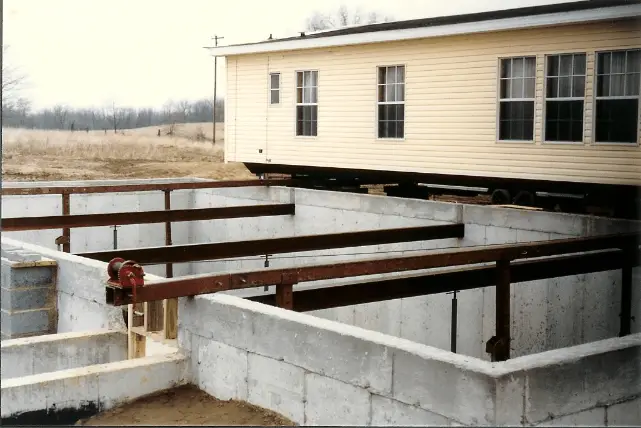
The actual conditions of the home site itself will also affect the longevity of a mobile home. If the lot is such that it is not graded well and has rainwater that pools underneath the home, the moisture will begin to deteriorate the underside of the home prematurely. This is especially true if the bellywrap has been torn open in a few places.
There are so many foundation methods that can be used for manufactured homes. Some of these methods are less expensive and some more. Some are meant to be less permanent while others are meant to be permanent. The location of the home site might play heavily into what type of foundation might be used. If the home is being set up in a mobile home park, it might use a different foundation type than would a home site that is heavily sloping on an individual lot somewhere.
If the manufactured home is being set up on any type of a pier foundation, which most are, then over time, the piers will settle causing the heavy metal chassis of the mobile home to flex. This in turn causes the mobile home above it to twist and flex. This in turn causes walls and ceilings to crack, floors to become noisy, doors and cabinets to not fit properly and plumbing to leak.
DAMAGE
Have you ever noticed the nature of people when it comes to taking care of their possessions? This is especially noticeable when it comes to cars. When someone buys a new car, or a used one for that matter, you’ll always hear them say that they are really going to take care of this one, unlike the junker they just traded in. What, did their character all of a sudden change when they bought the different car? Did they become a different person?
Obliviously not. They may take better care of that new car for a while, but slowly, the old habits and character traits of the person creep back in. Before long, the car gets a small scratch, a dent or stains in the interior. The owner tells themself that they will get it cleaned up or fixed. But, they never do. A few more items of damage happen and before long, the newer car becomes beat-up and dirty just like the owner’s previous car was.
Homes are no different. Finances also factor in. There are often times when something happens and the owner simply doesn’t have the financial ability to take care of the issues. This might be a leaky roof, a plumbing leak, a broken HVAC unit. The list could go on and on. Over time, if ignored, the problems with a home start to add up. The owner knows about the problems, but cannot take care of them. The home ends up becoming disheveled.
This is the exact formula that house flippers depend on. They want to find homes that are in a state of great disrepair. That way they can buy the homes for far under market, put in the work and capital needed to make the home like-new again, and then sell the home for a profit.
We have done this many times in our own business with both site-built homes and manufactured homes. With a little financing, it is quite easy to bring either type of home into better-than-new condition.
WATER DAMAGE
This is the worst kind of problem to NOT repair quickly. A leaking roof, toilet or plumbing fixture can pretty much ruin all the materials the water touches. It makes no difference whether it is in a site-built home or a manufactured home. If the water damage is left unchecked, minor problems can turn into major ones very quickly.
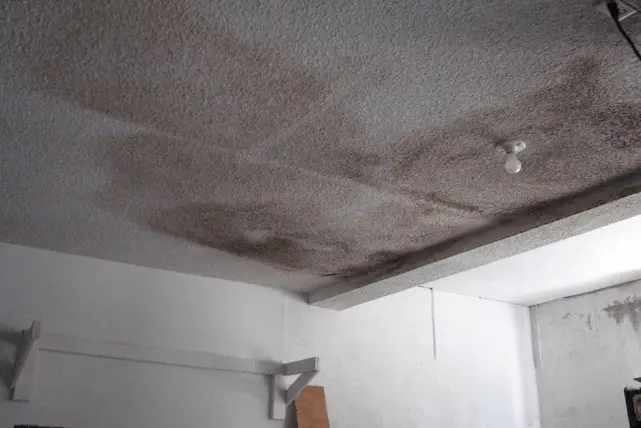
If the mobile home is in a location that receives lots of rain, it is important, as part of the maintenance, to keep a good coat of paint on the outside of the home, and the seams caulked well. Many mobile homes built during the 1980s were built with fiberboard siding which is very prone to water damage. By keeping the exterior of the home painted and sealed, this will prevent water damage and increase the life the home.
Extending The Serviceable Life Of Your Mobile Home
As per our discussion, the construction methods and materials used are not the culprit in shortening the life of a mobile home. Improper maintenance is.! While statistically, the average lifespan of a manufactured home may be 30 to 55 years, let’s look at some ways to extend that lifespan.
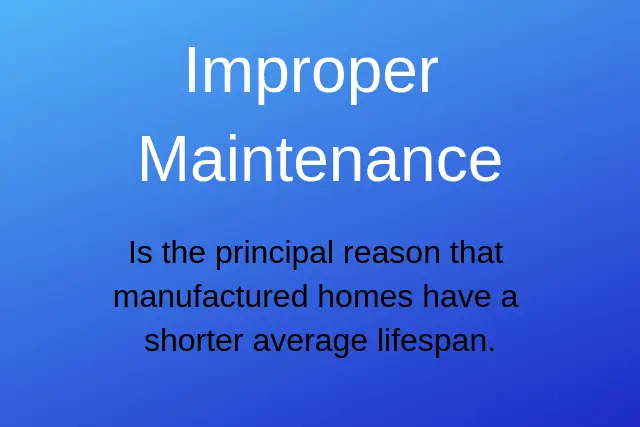
As per our discussion, the construction methods and materials used are not the culprit in shortening the life of a mobile home. Improper maintenance is. While statistically, the average lifespan of a manufactured home may be 30 to 55 years, let’s look at some ways to extend that lifespan.
For additional insight see our post “The 12 Most Common Problems With Older Mobile Homes!”
LOCATION
We’re not really talking about Arizona vs. Florida here, We are talking about choosing the right lot for a home, whether it be in a mobile home park or a lot in a subdivision. Any property will gain value by being in the right location. Also, choosing a good piece of land that supports a good foundation will extend the lifespan of the home.
INSPECTIONS
Having a professional inspection done is a great way to uncover things that need attention on the mobile home. This is especially true if you are noticing things being problematic such as leaks, cracking walls, or doors that will not shut. If there has been a recent flood, strong wind storms or other type of catastrophe, this would be a good time to have a professional inspection done.
ROOF MAINTENANCE
The roof is what stands between you and the elements of nature. Deferred roof maintenance is one of the principal culprits in shortening the life of a mobile home.
Many older mobile homes were built with rolled steel roofing. These have a tendency to leak between the seams and along the outer walls if they are not sealed and coated on a regular basis.
In fact, whenever we have been able to pick up a mobile home to flip for almost nothing, it is usually because the roof maintenance was deferred, the roof leaked over a period of time and destroyed walls, flooring and more. It is much less expensive to seal the roof, or replace worn shingles than it is to reroof the entire home.
SKIRTING
Keeping the skirting in good repair something that is easy to do and, next to the roof, one of the most important maintenance items. When skirting is missing, there is a much greater problem than just the awful look it gives the home. Animals love to come and take up residence underneath the home trying to stay warm and dry.
If there are holes in the bellywrap of the home, many animals will pull out the insulation to build nests. This includes rats, cats, raccoons and most any other animal that might roam through your area. One mobile home we flipped had more than 20 cat skeletons beneath it. Some were up in the insulation.
Skirting keeps the animals and elements out, and safeguards the bellywrap, insulation and foundation.
GENERAL MAINTENANCE
More than the large maintenance areas listed above, it is good to keep up on maintenance of the entire home. Small problems can turn into big ones very quickly. Before you know it, the home is in need of a major overhaul. Some of these areas include:
- Re-leveling the home when needed. (Are doors and windows not closing properly?)
- Caulking all exterior seams on any surface where water may enter.
- Keeping windows moving properly in their tracks and latching.
- Any plumbing leaks should be repaired immediately.
- Repair soft spots in the floors when they develop.
- Have any wiring issues taken care of by a professional.
Should You Remodel Your Home
Remodeling an older mobile home can be a great way to extend the serviceable life of the home. This is especially true if some of that budget is going to updating the siding, windows, roofing, floor or insulation. These are things that will make the home tighter and improving its efficiency.
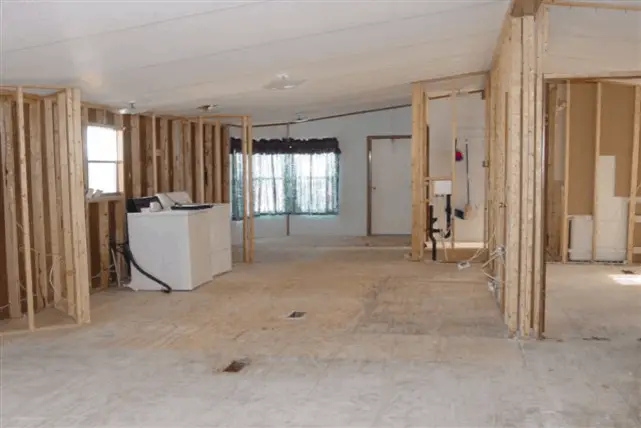
The decision is very dependent upon the mobile home. Let me relate some of our experiences when making the decision of what to do with a mobile home. We have had many mobile homes given to us that were in parks. We have taken them and remodeled them to the nines and sold them for a great profit. The only time we have turned down a home such as this is if the home is a pre-1976 non-HUD home.
Many of these old pre-HUD homes have very little if any insulation. Many only have 60 to 100 amp electrical panels which are inadequate for todays electrical needs. Often,the wiring and plumbing systems are sketchy at best, and most have non-uniform window and door sizes.
We have also purchased older pre-HUD homes that were on their own land. We knowingly purchased the homes understanding that the value of the property was in the land. We actually tore down one of the older homes because the construction of the home was very substandard and it was in very poor condition.
There was another older pre-HUD home on a lot that we purchased and actually put $10,000 into fixing the home up. The reason is that the home was solid, it had a few attached structures. And, after the remodel, it would rent for nearly the same price that a far more expensive newer home would command. It was a good investment decision.
So When Should A Mobile Home Be Scrapped?
When the home needs too many expensive repairs, or it has significant damage from insects, mold, water or rot, it might be time to cut your losses. There are also mobile home parks that homes cannot be older than a certain age. In these situations, you might find that it is more expensive to try to move the home than to just cut it in pieces and sell it for scrap.
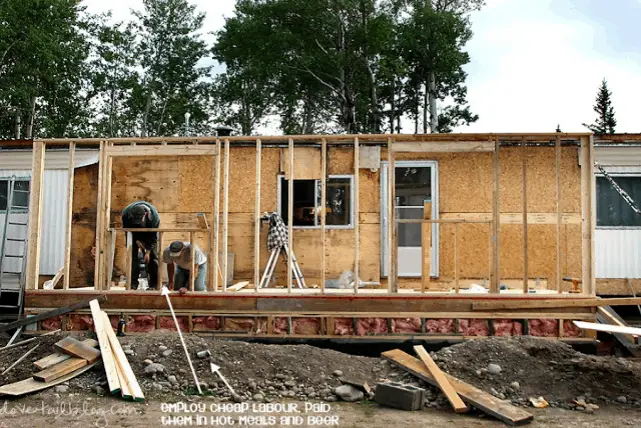
A good rule of thumb is that if the home is in such a condition that the cost of repairs for a remodel far surpass the finished value, then it might be time to think about scrapping. As part of this decision, you should weigh in what the home will be used for.
As I mentioned previously, we put a significant budget into an older pre-HUD home because the investment value of the rents were such that replacing the home with a far more expensive home would not have made us as good a return on investment as the older home did.
OBSOLESCENCE
With properties, we find for more stick-built homes that suffer from functional obsolescence than mobile homes. One of the reasons is that homebuyers typically have much higher expectations for a stick-built home. We are in the Phoenix, Arizona area. As a metro area, Phoenix is relatively new, but there are still plenty of homes built over 80 years ago. Many homes built earlier than the 1950s often have only one bathroom, very small bedrooms and dysfunctional kitchens.
These homes take far more work to renovate than an older mobile home from the 1970s. Mobile homes tend to be a narrow rectangle (single wide) or a wider rectangle (double wide). There are only so many ways to arrange the necessary rooms.
Also, with a mobile home, very few, if any interior walls are load bearing. This makes changing around the floor plan quite simple. The plumbing and ductwork run beneath the home making it easy and inexpensive to access for any planned changes.
So How Long Will A Mobile Home Last?
The lifespan of any dwelling, commercial building, site-built home, manufactured home, all comes down to the way the home is maintained. All of the dwellings above were designed and constructed to be permanent and to last as long as they are maintained well.
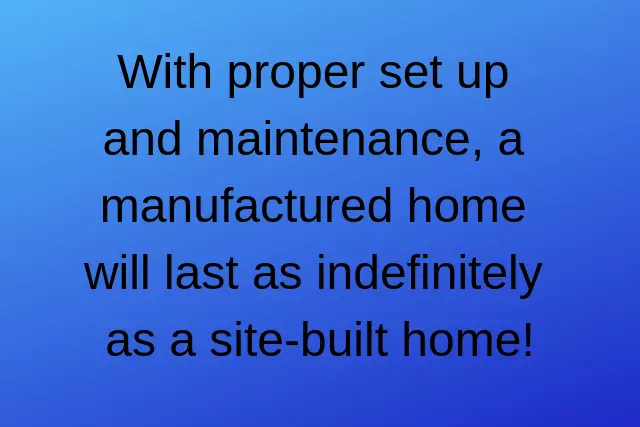
Many older mobile homes are owned by residents who simply cannot afford to maintain the home in top condition. The home slowly deteriorates over time as maintenance is deferred and neglected.
If you take care of a manufactured home the same way you would take care of a site-built home, it will last just as long. Proper maintenance is the key to making any dwelling last.
Yes, the average might be 30 to 55 years, but the same can be said of site-built homes that are improperly maintained.
Related Questions
DO MANUFACTURED HOMES APPRECIATE OR DEPRECIATE IN VALUE?
New Manufactured (Mobile) Homes – If you were to buy a brand-new manufactured home, there are far more costs involved than just the purchase price of the home. Getting it set-up on a lot can be expensive. Chances are that you would not be able to get your invested money back quickly on this type of purchase (Cost of home plus cost of lot and set-up.)
Pre-Owned Manufactured (Mobile) Homes – If you were to buy a resale mobile home for market value, there is a very good chance that it will increase in value over time very similarly to a stick-built home.
Any home is a large investment for most buyers, be it a traditional home or a manufactured (mobile) home. Appreciation and depreciation on a home should be a real concern for any prospective buyer. There are many variables that affect the resale value of mobile homes and we’ll address those factors in this blog post.
We’ll introduce you to the way we are able to make a profit with selling mobile homes. Even if you are planning on buying a home for your own use only, by using our techniques you’ll be sure to be in a position where you will gain resale value with your mobile home.
For more information see our blog post “Do Mobile Homes Have Good Resale Value?”
ARE MOBILE HOMES A GOOD RENTAL INVESTMENT?
- Mobile Homes Can Appreciate – Much like a stick-built home. The understanding of appreciation rather than depreciation is important. The mobile home appreciation rate may be slightly less, but they certainly do go up in value if purchased properly.
- Mobile Homes Rentals Offer A High Rate Of Return (ROI) – A good return on investment is the pillar rule for wise investing. Most real estate investments require a highly leveraged mortgage position and a good appreciation rate in order to provide a solid ROI. Mobile homes can offer a great return without any leverage or appreciation.
- Mobile Homes Are Inexpensive To Renovate – In our experience, we are able to completely renovate a mobile home for investment at a fraction of what it costs to do a traditional home.
- Mobile Homes Are Inexpensive To Maintain – The systems in a mobile home (plumbing, HVAC, electrical) have much easier access than in a stick-built home. Mobile homes tend to be smaller than most stick-built homes. We find it costs us far less to maintain a mobile home over the long haul than a traditional property.
- Mobile Homes Have A Large Market Interested In Renting Them – There is a far larger population of average to less than average income earners in most areas. We have always found it extremely easy to rent out our mobile homes to quality tenants.
- Mobile Home Tenants Tend To Stay Longer Than In Traditional Homes – In our experience, we have been able to keep tenants in our properties for many years. This is far longer than the typical six months to 1 years turnover rates on traditional homes.
For more information see our post “Are Mobile Homes A Good Rental Investment?”

